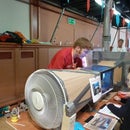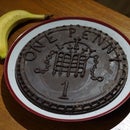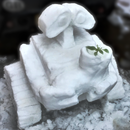Introduction: Pumpkin Minion With Ba-na-na
This is the first pumpkin I ever carved.
I thought it went quite well so I thought I'd share how I went about doing it.
I made it without any stencils, it is to my knowledge unique...
Step 1: Pick a Suitable Pumpkin and Gather Tools
Find a pumpkin that is roughly minion shaped. You are looking for a pumpkin that is more 'portrait' than 'landscape'. This one was grown in a local allotment and sold at the side of the road, it was much better shaped than the supermarket options. You also need a second pumpkin for the arms and feet. Pick an under-ripe one if possible for strength.
You also need a small banana. BA-NA-NA!!
Hidden parts (not pictured):
- Bamboo skewers
- Wooden cocktail sticks
Tools I used were:
- Small serrated knife
- Metal spoon
- Clay loop tool
- Scalpel
- A reference picture from the internet
- Elastic band (not pictured)
- Sharpie (not pictured)
- Iso-propyl alcohol (not pictured) - for removing the sharpie marks
In addition I used some other bits for lighting (I built this for a work competition so candles were off limits)
- 12V wall wart
- GU4 bulb holder
- Drill bit (to make a hole for the cable)
- PSU socket to solderless connector (not pictured)
- GU4 LED light (not pictured)
Step 2: Start Drawing Your Design - Face
I drew my design in Sharpie (other permanent marker brands are available). I generally tried to keep the marks to areas of skin that would be removed but I also used IPA and kitchen towel to remove other marks when needed. Bear in mind that the Sharpie can leave stains on the cut edges when wiped off so try to avoid marking areas that won't be cut off or remove lines before cutting where possible.
For the goggle, I found a suitably sized aerosol cap and drew around it. I added the iris and pupil by hand. I also added a line inside and a line outside the goggle circle to add thickness and leave the middle line to carve out so the goggle ring gets illuminated.
In order to make the strap for the goggle I wrapped an elastic band around the pumpkin - this achieves a much more natural line than trying to draw it free hand. Draw along the top edge of the elastic band, then reposition for the lower edge of the strap (make sure it is constant width all the way around) and draw again. Adding the attachment detail helps make the design hang together but is not strictly needed.
For the mouth I copied from my reference picture freehand.
It is important to keep track of how much of the pumpkin should be face. If at this point the face is too big or small, it is easy to rub off the design with IPA and do it again. Better to fix it now than put in all the effort and not be happy later.
Step 3: Drawing the Dungarees
Once again using an elastic band (and viewing the reference image for proportions) start adding the lines for the dungarees. The elastic band method works really well here, take note that the bands over the arms are at a very shallow angle due to the minion's lack of shoulders. Check your reference image, it is easy to get this wrong.
After drawing the main shape of the dungarees front and back I went back and added details like buttons, pockets and the Gru Industries logo, even though I would wipe these off before making the cuts it is good to get a feel for how it should look.
Step 4: Opening the Top of the Pumpkin
Using the short serrated knife, carefully slice along the top to the goggle strap and then around the top of the goggle. This edge will be an edge between carved pumpkin and untouched skin, hiding the split.
Angle the blade downwards to make a conical cut so the top sits on stably.
Once the top is removed, use the metal spoon to scoop out the innards and scrape the inside of the flesh to get a nice even surface to let the light through.
Step 5: Hair and Carving the Top
Stuart the minion has a fashionable centre parting with a small number of hairs lying flat either side.
Starting by the stalk I cut around three 'hairs' and scraped the material away from around them. The rest of the top piece needs carving evenly.
I used the serrated knife held flat to the pumpkin and using a sawing motion to carve the large areas.
Close to the hairs and the stalk, the knife can't get in so I used a clay sculpting loop tool I happened to have to remove the material. Where even that couldn't get I used the point of the scalpel - Be careful not to snap the blade like I did!
Step 6: Carving More of the Face and Body
Using the clay sculpting loop tool, remove the skin and top layer of flesh from the areas of minion skin. I cut the edges with a scalpel (outside the line so it gets cut away), carved a groove inside this cut with the loop tool and then removed the remaining skin.
For the teeth I cut into the flesh more deeply with the scalpel to transfer the outline of the teeth. I then removed the skin to a shallow depth and then dug deeper in the space between teeth. I then used the loop tool to shape the teeth.
To give the mouth an outline when illuminated I made a last minute decision to leave a thin line of skin as lips. This is a compromise but really adds to the look when illuminated in the dark. I carefully wiped off the sharpie marks as well as I could and then trimmed the stained edges with the scalpel.
Step 7: Arms and Feet (pumpkin Number 2)
Slice the base off the second pumpkin as flat as you can and about an inch (25mm) thick. Place the slice cut side down on a chopping board and try to level it as required until it stands squarely without rocking or bending.
Place the minion pumpkin on top and find the position in which it fits most stably and mark all the visible areas except where you want the feet to stick out. Cut away the visible area, leaving the base for the pumpkin to sit on and the two feet. A relatively stable base can be achieved because much of it is hidden under the main pumpkin.
Other than carving shoe shapes this can be crudely cut out as it isn't very visible. I left the tops of the shoes with skin on so the colour looks better
The arm without the banana is a slender arm with a gloved hand carved on the end, again using the loop tool. You will find the shape somewhat controlled by the curvature of the donor pumpkin but minion arms are generally curved so it looks ok.
The hand holding the banana needs to be a bit oversize. Hold the banana against the end and then mark and cut a groove that just fits the banana. Then cut away as much material as you dare without losing the strength required while carving the gloved hand. This arm needs leaving stockier to take the weight of the banana. Picking a small banana really helps.
Also there is plenty of spare material in this pumpkin if it doesn't go right first time.
Step 8: Attaching Limbs and Adding Scalpel Details
I recommend finishing all the carved details before assembly to avoid working around a relatively fragile arm like I had to.
The arm that holds the banana needs really good mechanical attachment. I used two bamboo skewers cut down to about 6 inches (150mm). I inserted one skewer 3 inches into the arm and then another beside it being careful to make sure it was very parallel (by eye).
I marked the place where the arm would go by pressing the ends of the skewers in to mark the flesh. I then used skewers to make two more parallel holes in the pumpkin at the correct angle to hold the arm. The arm slid on easily but needed some force.
At this point I realised it wasn't coming off so I had to be careful finishing the details off:
Using two angled scalpel cuts to remove thin strips of skin I added edges to the dungaree straps, details to the goggle, pockets, and the Gru Industries logo (copied from the reference image). I also made a number of radial cuts to the iris to differentiate it from the pupil.
Three parallel vertical cocktail sticks in the base allows the main pumpkin to be carefully lowered on to be much more stable. Another cocktail stick holds the other arm on. Placing the banana in the hand centrally to keep it balanced finishes the look.
Step 9: Illumination
Traditionally a pumpkin should be illuminated with fire, for which you would need to add air holes. If I was doing this I'd add an eyelid to support the iris/pupil of the eye and remove the white of the eye. I'd probably remove the mouth behind the teeth too.
However my pumpkin was made for my work competition and naked flames in the office is a no-no. Luckily I had some GU4 bulb holders and LED lights hanging over from my exhaust lamp project. These are 12V so nice and safe and easy to power with an 8AA battery pack or a wall wart (I have since used both).
I used a 7mm wood drill bit to add a hole for the cable by hand, and passed the cable through. My LED lights shine sideways from the socket so it was easy to point it upwards. 3 cocktail sticks were added to hold it and stop it turning over. For simplicity I clipped my solderless 2.1mm power socket to the cable and plugged it into a wall wart (and when placed outside, a battery pack).
The warm glow looked pretty authentic so I was very happy with the result.
Step 10: Enjoy Your Creation
I made this for my work's pumpkin competition where it was very well received - I won:)
I also enjoyed making it and the local kids seemed to love it when they went trick or treating as well.
I hope you've enjoyed this instructable. If you have, please vote for me in the contest!

Participated in the
Halloween Decor Contest 2016

Participated in the
Pumpkin Carving Contest 2016











